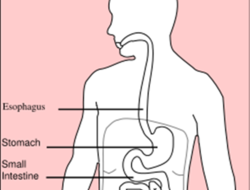The Small Intestine and Digestion
Published: December 10, 2020
Your small intestine is composed of three sections, the duodenum, jejunum and the ileum.
It is the longest section of the gastrointestinal tract (GI) and is situated between your stomach and your large intestine.
Together, the three continuous sections of your small intestine form an approximately 3 metre (10 feet) long coiled tube located within your abdominal cavity (the space between your ribs and hips).
The walls of this tube consist of the characteristic longitudinal and circular smooth muscles which sustain peristalsis.
Peristalsis is the periodic wave-like muscular contraction which moves ingested food along your GI tract as part of the digestive process.
The muscular contractions occur between 12 and 16 times a minute.
Two sphincter muscles, one at each end of your small intestine, open and close periodically to pass digested food from one section of your GI tract to the next, and prevent food passing back to the previous section.
The pyloric sphincter controls the passage of partially digested food from the stomach to the duodenum, and the ileoceal sphincter controls the passage of the remnants of digestion from the ileum to your large intestine.
The central space of the intestinal tube through which your food passes is called the lumen.
The folded or pleated arrangement of the wall of your small intestine, which surrounds the lumen, greatly increases the surface area of the intestinal wall throughout the small intestine.
This increases the absorptive function of your small intestine.
Under a microscope the pleats appear as finger-like projections into the lumen. These finger-like projections are known as "villi" which contain hundreds of cells.
Each villi is covered with "micro-villi" which resemble tiny hairs that function to catch nutrients as they are released during the digestive process.
Your small intestine is the principle site of digestion and absorption of nutrients from the food and beverages you consume.
You liver, gall bladder and pancreas are auxiliary organs that produce bile and pancreatic juice which facilitate the digestion and absorption processes.
These fluids are released into the duodenum through the bile duct and pancreatic duct. CCK, a hormone produced and released from intestinal cells, promotes...link to the full article to learn more.
References
1.
Whitney, E. & Rady Rolfes, S. (2005). Understanding Nutrition. Belmont, CA: Thomson Wadsworth
2.
Gropper, S.S., Smith, J.L. & Groff, J.L. (2005). Advanced Nutrition and Human Metabolism (4thEd.). Belmont, CA: Thomson Wadsworth.

